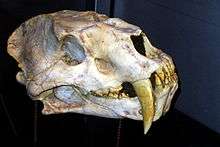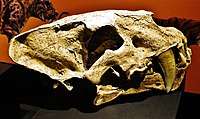Amphimachairodus
Amphimachairodus is an extinct genus of large machairodonts belonging to the clade known as Eumachairodontia (true saberteeth) along with relatives like Smilodon and Homotherium.[2] It is also a member of the tribe Homotherini within Machairodontidae and is most closely related to such species as Xenosmilus, Homotherium itself, and Nimravides. It inhabited Eurasia, Northern Africa and North America during the late Miocene epoch.[3][4]
| Amphimachairodus | |
|---|---|
 | |
| A. giganteus skull. | |
| Scientific classification | |
| Kingdom: | Animalia |
| Phylum: | Chordata |
| Class: | Mammalia |
| Order: | Carnivora |
| Suborder: | Feliformia |
| Family: | Felidae |
| Subfamily: | †Machairodontinae |
| Tribe: | †Homotherini |
| Genus: | †Amphimachairodus Kretzoi, 1929 |
| Type species | |
| †Machairodus palanderi (Zdansky 1924) synonymized with Amphimachairodus giganteus Kretzoi, 1929 | |
| Species[1] | |
| |
Description
There was marked sexual dimorphism in A. giganteus, with males being much larger than females.[5]
The species Amphimachairodus coloradensis, from the United States (formerly Machairodus coloradensis) was a significantly large animal, about 1.2 m (3.9 ft) at the shoulder, according to skeletal and life reconstructions, potentially making it one of the largest known felids.[6] All Amphimachairodus species have a developed mandibular flange, however, A. colaradensis is distinguishable from A. giganteus and A. kurteni by subtle differences in the shape of the mandible and placement of lower carnassials. In size and proportions, the Eurasian species A. giganteus was remarkably similar to a modern lion or tiger and had a shoulder height of 1.1 m (3.6 ft). This species has a skull length of around 14 in (36 cm).[7]. The African species A. kabir (formerly Machairodus kabir) is suggested to have weighed over 350 kg (770 lb). This would make it comparable in size to Xenosmilus, Machairodus horribillis and slightly smaller than Smilodon populator.
Amphimachairodus was about 2 metres (6.6 feet) long and probably hunted as an ambush predator. Its legs were too short to sustain a long chase, but it most likely was a good jumper. It probably used its canines to cut open the throat of its prey, severing the major arteries and possibly crushing the windpipe. Its teeth were rooted to its mouth and were not as delicate as those of most other saber-toothed cats of the time, which had extremely long canines that hung out of their mouths. The fangs of Amphimachairodus, however, were able to easily fit in its mouth comfortably while being long enough to be effective for hunting.[8] Amphimachairodus also possessed a longer tail than most other large machairodont genera.[9]
Skull
This specimen was from a large male A. giganteus with the skull measuring 14 in (36 cm) from the Late Miocene in China, comparable to a male lion or tiger.[10] Deformation of the skull through natural fossilization processes has changed the shape slightly, making it asymmetrical, but overall it remains an excellent specimen for studying the cranial morphology of this particular genus and species.
For felines, this skull is rather long, but rivaled by the skulls of the two largest species of extant cats: the lion and tiger.[11] When compared with the skull of a regular lion, it is long and very narrow, particularly in the muzzle and width of the zygomatic arches. Its sagittal crest is well pronounced. Compared with other machairodonts, the canines are stout and capable of large amounts of stress. This characteristic is slightly remodeled in females, whose canines are slimmer and generally longer.[12] Compared with females, the orbit of males are smaller, muzzles larger, the anterior-most portion of the nasal bones generally flare upwards slightly, and the downward slope of the dorsal edge of the skull in front of the orbit is not as pronounced, producing a straighter profile. Compared with the most well known machairodont Smilodon, commonly referred to as the "saber-toothed cat", the canines are much shorter, the facial portion again is much longer, and the teeth not reduced so far in number. Several machairodonts, namely Megantereon, bear flanges on the mandible, which are very reduced in A. giganteus though characteristics of the mandible associated with the flanges are present, particularly the lateral flattening of the anterior portion of the mandible, creating a cross section more square than semi-circular. The dental formula for this specimen is 3.1.2.13.1.2.1.
Paleoecology

Amphimachairodus was an inhabitant of woodlands and open floodplains as based on finds in Pikermi in Greece and Shanxi Province in China, indicating it had habitat preferences similar to modern lions in many respects. Specimens recovered from Turolian deposits indicate that the fauna living there was much the same, differing only by species in many cases. Among the creatures it shared its environment with were bovids such as Parabos, Lutung monkeys, the mastodon Anancus, the rhino Aceratherium, antelopes such as Tragoportax and Miotragocerus as well as gazelles and deer, a very large species of hyrax, early goats, various giraffes, camels such as Paracamelus, the horse Hipparion, a species of aardvark, the chalicothere ancylotherium and the beaver-like Dipoides. Other carnivores it shared its territory with include the bear Agriotherium, fellow machairodonts Metailurus and Paramachairodus and hyenas like Thalassictis. [13].
The larger herbivores were likely common prey for Amphimachairodus, and it likely would have competed with Agriotherium for food, possibly yielding kills to the bear and possibly also stealing kills from hyenas such as Thalassictis and from Metailurus when the opportunity arose.[14].
In North America, in places such as Coffee Ranch in Texas, Amphimachairodus coloradensis shared territory with Agriotherium as it had in Africa and Eurasia, but also shared territory with the feliform Barbourofelis and the canids Epicyon and Borophagus, and herbivores like the camel Aepycamelus, the pronghorn antelope Cosoryx, horses like Neohipparion and Nannippus, the peccary Prosthennops and rhinoceroses like Teleoceras.[15][16]
In the Djurab desert in northern Chad, Amphimachairodus kabir co-existed with fellow machairodonts Lokotunjailurus, Tchadailurus and early representatives of the genus Megantereon. In addition, animals such as crocodiles, three-toed horses, fish, monkeys, hippos, aardvarks, turtles, rodents, giraffes, snakes, antelopes, pigs, mongooses, foxes, hyenas, otters, honey badgers and the hominid Sahelanthropus dwelled here, providing ample food. Based on these and other fossils, it is theorized that the Djurab was once the shore of a lake, generally forested close to the shore with savannah-like areas some distance away.[17] The great number of cat species in the environment indicates that there was significant prey and available niches for multiple species of large felids to coexist.[18][19]
See also
- Big cat
- List of largest carnivorans
- List of largest prehistoric carnivorans
- Megafauna
- Homotherini
- Miocene
- Quaternary extinction event
References
- Sardella, Raffaele; Werdelin, Lars (2007). "Amphimachairodus (Felidae, Mammalia) from Sahabi (Latest Miocene-earliest Pliocene, Libya), with a review of African Miocene Machairodontinae". Revista Italiana di Paleontologia e Stratigrafia. 113 (1).
- Christiansen, P. (2012). "Phylogeny of the sabertoothed felids (Carnivora: Felidae: Machairodontinae)". Cladistics. 29 (5): 543–559. doi:10.1111/cla.12008.
- Werdelin, L; O'Brien, S.J.; Johnson, W.E.; Yamaguchi, N. (2010). "Phylogeny and evolution of cats (Felidae)". In Macdonald, D.W.; Loveridge, A.J. (eds.). Biology and Conservation of Wild Felids. Oxford: Oxford University Press.
- Anton, Mauricio (2013). Sabertooth.
- Turner, A.; Antón, M. (1997). The Big Cats and Their Fossil Relatives: An Illustrated Guide to Their Evolution and Natural History. Columbia University Press. ISBN 978-0-2311-0229-2. OCLC 34283113.
- Turner, Alan; Anton, Mauricio (1997). The Big Cats and Their Fossil Relatives.
- Augusti, Jordi (2002). Mammoths, Sabertooths, and Hominids: 65 Million Years of Mammalian Evolution in Europe. p. 195. ISBN 978-0-2311-1641-1.
- Legendre, S.; Roth, C. (1988). "Correlation of carnassial tooth size and body weight in recent carnivores (Mammalia)". Historical Biology. 1 (1): 85–98. doi:10.1080/08912968809386468.
- Anton, Mauricio (2013). Sabertooth.
- "Male Machairodus giganteus skull". Black Hill Institute.
- Heptner, V. G.; Sludskii, A. A. (1992) [1972]. Mlekopitajuščie Sovetskogo Soiuza. Moskva: Vysšaia Škola [Mammals of the Soviet Union, Volume II, Part 2]. Washington DC: Smithsonian Institution and the National Science Foundation. pp. 83–202. ISBN 978-90-04-08876-4.
- "Female Machairodus giganteus skull".
- Augusti, Jordi (2002). Mammoths, Sabertooths, and Hominids: 65 Million Years of Mammalian Evolution in Europe. pp. 182–190. ISBN 978-0231116411.
- Antón, Mauricio (2013). Sabertooth. Bloomington, Indiana: University of Indiana Press. pp. 53–54. ISBN 9780253010421.
- Antón, Mauricio (2013). Sabertooth. Bloomington, Indiana: University of Indiana Press. p. 39. ISBN 9780253010421.
- Turner, Alan (1997). The Big Cats and their fossil relatives. New York: Columbia University Press. p. 201. ISBN 978-0-231-10228-5.
- http://www.livescience.com/10416-sabertooth-cats-feasted-early-humans.html
- Science Press
- Scientific American
